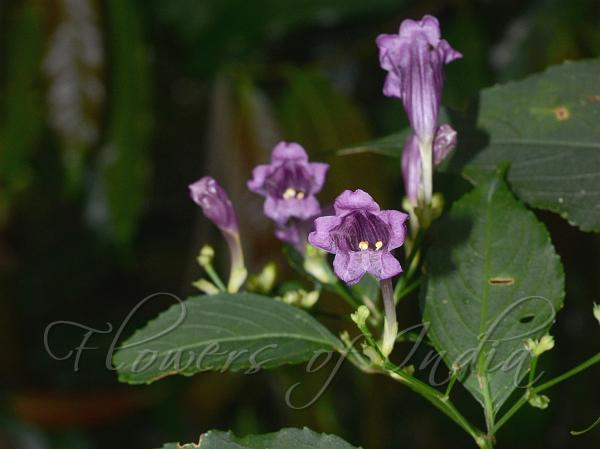|
| Naga Coneflower |
|

|

| File size | 623709 |
| Original date | 9/26/18 1:40 PM |
| Resolution | 3264 x 4928 |
| Flash | Flash fired, return detected |
| Focal length | 60.0mm |
| Exposure time | 1/250s |
| Aperture | 11.0 |
| Focus Distance | |
| Metering Mode | Multi-segment |
| Camera make | NIKON CORPORATION |
| Camera model | NIKON D7000 |
| Sensor type | OneChipColorArea |
|
|
|
|
Photo: |
Botanical name: Strobilanthes discolor Family: Acanthaceae (Acanthus family)
Synonyms: Goldfussia discolor, Strobilanthes nagaensis, Diflugossa nagaensis
Synonyms: Goldfussia discolor, Strobilanthes nagaensis, Diflugossa nagaensis
Naga Coneflower is a subshrub up to 1.8 m tall, with
leaves in strongly unequal pairs. Flower are violet, trumpet shaped,
3.2-3.8 cm, hairless, tube basally cylindric and about 2 mm wide for
8-10 mm then gradually widened to about 1 cm at mouth; lobes ovate, 5-6
x 6-7 mm, tip rounded. Stamens are 4; longer filament pair 7-8 mm,
style 2.3-2.8 cm. Sepal-cup is 5-lobed almost to base; sepals flowering
are linear-oblong, 5-7 x about 1 mm, nearly equal, tip blunt. Sepals in
fruit are almost spoon-shaped, growing to about 1 cm, often
gland-tipped hairy. Flowers are borne in leaf-axils, in stalked heads,
often with secondary branching and becoming panicle-like. Floral bracts
are inverted-lanceshaped to spoon-shaped, 3-5 x 1-2 mm, rapidly falling
off. Stems and branches are 4-angled to almost round, grooved.
Leaf-stalks are 0.5-2.5 cm, grooved, hairless; leaf blade elliptic to
ovate-elliptic, 3-14 x 2-6.5 cm, hairless, both surfaces with prominent
cystoliths, below whitish, above dark green, secondary veins 6-8 on
each side of midvein, base narrowed, shortly decurrent onto leaf-stalk,
and often slightly oblique, margin sawtoothed, tip tapering to with a
tail and often curved Capsules are narrowly obovoid, about 10 x 2.5
mm, 4-seeded. Naga Coneflower is found in the Himalayas, predominantly
in East Himalaya to Tibet and Myanmar. Flowering: October-February.
| Identification credit: John Wood | Photographed in Reiêk tlâng, Ailâwng, Mizoram. |
• Is this flower misidentified? If yes,